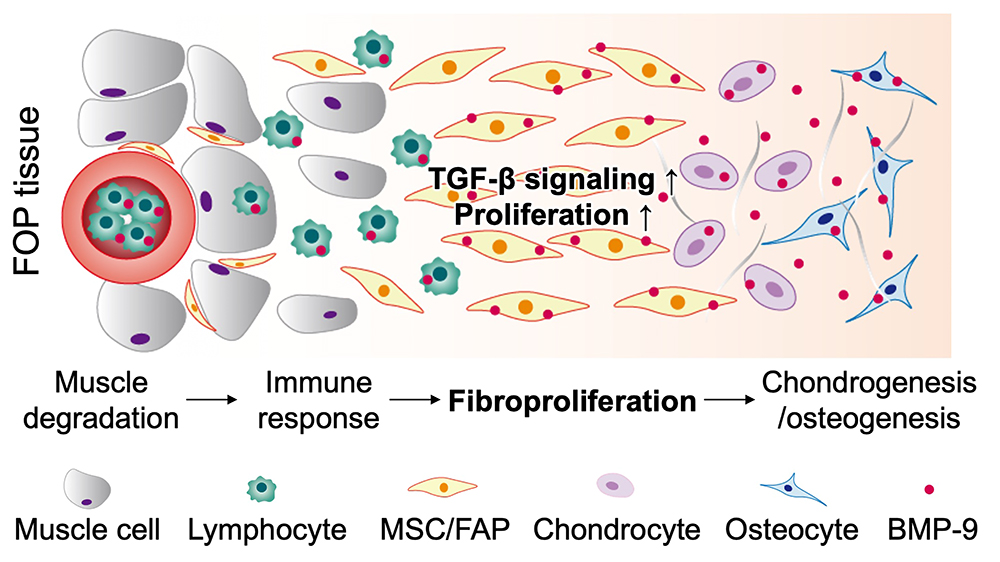
News & Events
News & Events
News
December 04, 2024
Preventing painful BMP-9-mediated flare-ups in fibrodysplasia ossificans progressiva
Fibrodysplasia ossificans progressiva (FOP) is a rare genetic disorder in which abnormal bone formation progressively replaces muscle and connective tissues due to a mutation in the ACVR1 gene encoding a bone morphogenetic protein (BMP) type I receptor in >95% of FOP patients that aberrantly activate BMP signaling by Activin A, a TGF-β ligand. This heterotopic ossification (HO) is typically associated with flare-ups, which are recurrent episodes of painful soft tissue swelling triggered by trauma from minor injuries. Flare-ups often result in the proliferation of fibroadipogenic progenitors (FAPs), a subtype of mesenchymal stromal cells (MSCs) responsible for much of the abnormal bone formation leading to HO. As such, inhibition or suppression of FAP proliferation could limit disease progression. Nonetheless, the molecular mechanisms underlying flare-ups remain largely unknown.
To better understand flare-up mechanisms, the research team first attempted to identify molecules responsible for triggering the MSC proliferation in FOP patients. For this, they tested a panel of potential ligands on MSCs de rived from iPS cells generated from an FOP patient (FOP-iMSCs) and MSCs corrected for the ACVR1 mutation (resFOP-iMSCs). Whereas several TGF-β and BMP ligands had similar effects on the proliferation of FOP- and resFOP-iMSCs, BMP-9 specifically enhanced the growth of FOP-iMSCs, an observation further confirmed using iMSCs from another FOP patient. Additional experiments examining a cell proliferative marker and progression through the cell cycle further supported a specific role of BMP-9 in FOP-iMSCs.
The researchers subsequently examined the significance of their findings in vivo by injecting BMP-9 into the muscles of FOP model mice with the same mutation as in FOP patients. Notably, the intramuscular BMP-9 injection led to changes in the tissue resembling flare-ups, including abnormal cartilage and bone formation, as well as increased FAP accumulation, only in mice expressing mutant ACVR1.
To further investigate the role of BMP-9 in FOP pathology, the research team artificially induced muscle injury by injecting cardiotoxin into the calf muscle of FOP model mice. Detailed examination of the injury site revealed proliferative BMP-9-positive cells and a BMP-9-rich extracellular matrix in the vicinity, potentially leading to the observed rise of serum BMP-9 levels. By contrast, while the intramuscular cardiotoxin injection into healthy mice increased BMP-9-positive cells at the injury site, their accumulation gradually resolved as the muscle regeneration began, and no significant increase in serum BMP-9 levels was observed. Furthermore, the researchers revealed that monocytes and macrophages forming the initial inflammatory response were the primary BMP-9 source causing aberrant FAP accumulation in later stages of the muscle injury and HO in FOP model mice.
To determine whether these findings may have implications as potential FOP treatments, the researchers employed genetic and pharmacologic approaches to demonstrate the critical contribution of BMP-9 to HO in FOP. Both in FOP model mice with a deletion of the BMP-9 gene or treated with a BMP-9 neutralizing antibody, HO progression following intramuscular cardiotoxin injection was attenuated. Furthermore, the antibody-based BMP-9 neutralizing study, in which the antibody was administered during different times, demonstrated that inhibition of BMP-9 is most effective during early stages to prevent HO progression.
Finally, to understand how BMP-9 triggers FAP proliferation, the research team examined the gene expression profiles of FOP- and resFOP-iMSCs following BMP-9 treatment. As expected, this analysis suggested an enhancement in TGF-β signaling, further confirmed by experiments to examine TGF-β activation specifically, including the phosphorylation of downstream signaling molecules, SMAD2/3. Based on these observations, the researchers tested whether genetic or pharmacologic inhibition of ACVR1-SMAD signaling would attenuate the proliferation of FOP-iMSCs. Through these experiments, they found that DMH1, a small molecule that occupies specifically the SMAD binding site in ACVR1, suppressed BMP-9-induced FOP-iMSC proliferation despite having no effects on TGF-β-induced proliferation of FOP- and resFOP-iMSCs. Similarly, they revealed that the genetic inhibition of SMAD2/3-mediated TGF-β signaling by siRNA-mediated knockdown significantly repressed the aberrant proliferation of FOP-iMSCs.
Through this study, the research team revealed the critical involvement of BMP-9-mediated MSC proliferation during flare-ups in FOP patients. Furthermore, the researchers demonstrated the therapeutic efficacy of several potential strategies to prevent damages caused by this aberrant signaling triggered by BMP-9, thus providing hope for novel treatment options to minimize the painful flare-ups characteristic of FOP.

Paper Details
- Journal: EMBO Molecular Medicine
- Title: BMP-9 mediates fibroproliferation in fibrodysplasia ossificans progressiva through TGF-β signaling
- Authors:
Chengzhu Zhao1,2,*, Yoshiko Inada2, Souta Motoike2, Daisuke Kamiya2,3, Kyosuke Hino2,4, Makoto Ikeya2,3,*
*: Corresponding authors - Author Affiliations:
- Key Laboratory of Clinical Laboratory Diagnostics (Ministry of Education), College of Laboratory Medicine, Chongqing Medical University
- Center for iPS Cell Research and Application (CiRA), Kyoto University
- T-CiRA Discovery and Innovation, Takeda Pharmaceutical Co., Ltd.
- Regenerative & Cellular Medicine Kobe Center, Sumitomo Pharma Co., Ltd.






















